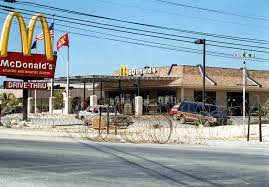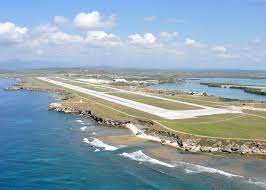LA BASE NAVAL DE LOS ESTADOS UNIDOS EN GUANTÁNAMO, CUBA. HISTORIA Y ACUERDOS DE PAGOS. FOTOS
La Base Naval de la Bahía de Guantánamo, conocida oficialmente como Estación Naval de la Bahía de Guantánamo o NSGB, (también llamada GTMO, pronunciado Guantánamo como jerga por miembros del ejército de los EE. UU.) es una base militar de los Estados Unidos ubicada en 45 millas cuadradas (117 km2) de tierra y agua en la costa de la Bahía de Guantánamo en el extremo sureste de Cuba. Ha sido arrendada permanentemente a los Estados Unidos desde 1903 como estación de carbón y base naval, lo que la convierte en la base naval estadounidense en el extranjero más antigua en el mundo
Desde hace 113 años (1903), este pedacito de Cuba está bajo el control de Estados Unidos por una renta anual que podría pagarse mensualmente por un buen apartamento en una gran ciudad.
La historia de Lease Guantánamo está llena de curiosidades y es uno de los principales obstáculos en el proceso de deshielo que iniciaron dos países el 17 de diciembre de 2014. Cuba insiste especialmente en dos aspectos para que la normalización de relaciones entre dos países, enemigos ideológicos desde hace más de medio siglo, se consuma.
El primero es el fin del embargo económico y comercial que Estados Unidos impuso a la isla desde 1961.
El segundo es el regreso de la base de Guantánamo, ubicada en la región del mismo nombre en el sureste de la isla, frente a las costas de Haití, un lugar estratégico en el Mar Caribe.
Las instalaciones militares en la Bahía de Guantánamo tienen estacionados allí a más de 8.500 marineros e infantes de marina estadounidenses. Es la única base militar que Estados Unidos mantiene en un país socialista.
En 2005, la Marina de los EE. UU. completó un proyecto de energía eólica de $ 12 millones en la base, erigiendo cuatro turbinas eólicas de 950 kilovatios y 275 pies de altura (84 m), reduciendo la necesidad de combustible diesel para alimentar los generadores diesel existentes (la generación de electricidad principal de la base). En 2006, las turbinas eólicas redujeron el consumo de combustible diesel en 650 000 galones estadounidenses (2,5 millones de litros) al año.
LA ENMIENDA PLATT
Desde 1903 concretamente, cuando Estados Unidos intervino en la guerra de Cuba contra España para lograr la independencia en 1898. Pero el apoyo no fue gratuito.
En la primera Constitución de la República de Cuba, Washington forzó la inclusión de la llamada Enmienda Platt, por la cual la isla se vio obligada a ceder partes de su territorio a su vecino del norte.
Se reconoció la soberanía de Cuba, pero se conservó la influencia suficiente para proteger los intereses estadounidenses.
Así, el 16 de febrero de 1903, los presidentes de ambos países, Tomás Estrada Palma y Theodore Roosevelt firmaron un acuerdo por el que Cuba cede a los Estados Unidos “durante el tiempo que sea necesario y con fines de estación naval y carbonera” dos territorios en Guantánamo y Bahía Honda. Este último nunca se materializó.
En el acuerdo se reconoció la soberanía de Cuba, pero el territorio bajo “total jurisdicción y control” de Estados Unidos.
El 2 de julio de 1903 los dos países firmaron un tratado en el que se especifican los detalles del contrato de arrendamiento. Por ejemplo, Estados Unidos es responsable de mantener la cerca. Y el precio: “La suma anual de dos mil dólares en moneda de oro de los Estados Unidos”.
Entonces veremos realmente qué valor monetario tiene este anacronismo.
Ese precio era alto para la época, pero Cuba no incluyó ningún ajuste de precios, por lo que ahora alquilar los 116 kilómetros cuadrados es insignificante.
Pero más que “casi nada” sería más estricto decir “nada”. Desde el triunfo de la Revolución en la isla en 1959, Cuba cobraba una sola vez el cheque de la renta anual. “El (cheque) de 1959, por mera confusión, fue convertido a renta nacional. Desde 1960 hasta hoy nunca han sido cobrados y son prueba de un tax lease por más de 107 años”.
Además, como la renta no es a perpetuidad, podría cesar tan pronto como el Pentágono reconozca que su uso ya no es necesario.
Parece improbable que suceda algo así. La entrega, si llegara a ocurrir, será para los gobiernos futuros.
LOS PAGOS DE LA BASE NAVAL
El Departamento del Tesoro de los Estados Unidos continúa enviando cheques a Cuba.
Luego del ajuste que hizo EE.UU. en 1973, la cifra llegó a US$ 4.085.
Cuba no está cobrando los cheques, según el profesor Michael Strauss, docente del Centro de Estudios Diplomáticos y Estratégicos de París, autor de “El arrendamiento de Guantánamo” (2009) y quizás el mayor experto en la curiosa relación jurídica “que afirma que se cancelan si no son efectivos en un año”.
Están a cargo de la Marina de los EE.UU. y tienen como destino al Tesorero General de la República de Cuba, figura que desde hace años no forma parte de la estructura de gobierno de la isla.
“Gracias a Cuba, es el mejor juego del presupuesto de Estados Unidos”, bromea Strauss.
UNITED STATES NAVAL BASE IN GUANTANAMO, CUBA. HISTORY. PAYMENT AGREEMENTS. PHOTOS
Guantanamo Bay Naval Base, officially known as Naval Station Guantanamo Bay or NSGB, (also called GTMO, pronounced Gitmo as jargon by members of the U.S. military is a United States military base located on 45 square miles (117 km2) of land and water on the shore of Guantánamo Bay at the southeastern end of Cuba. It has been permanently leased to the United States since 1903 as a coaling station and naval base, making it the oldest overseas U.S. naval base in the world.
Since 113 years (1903) ago, this little piece of Cuba is under US control for an annual rent that could be paid monthly for a good apartment in a big city.
Lease history Guantanamo is full of curiosities and is one of the main obstacles in the process of thaw that began two countries on December 17, 2014. Cuba insists especially on two aspects to the normalization of relations between the two countries, ideological enemies for more than half a century, is consumed.
The first is the end of the economic and commercial embargo that the US imposed on the island since 1961.
The second is the return of Guantanamo base, located in the region of the same name in the southeast of the island, off the coast of Haiti, a strategic location in the Caribbean Sea.
The military facilities at Guantanamo Bay have over 8,500 U.S. sailors and Marines stationed there. It is the only military base the U.S. maintains in a socialist country.
In 2005, the U.S. Navy completed a $12 million wind-power project at the base, erecting four 950 kilowatt, 275-foot tall (84 m) wind turbines, reducing the need for diesel fuel to power the existing diesel generators (the base’s primary electricity generation). In 2006, the wind turbines reduced diesel fuel consumption by 650,000 U.S. gallons (2.5 million liters) annually.
THE PLATT AMENDMENT
Since 1903 specifically, when the United States intervened in Cuba’s war against Spain to achieve independence in 1898. But the support was not free.
In the first Constitution of the Republic of Cuba, Washington forced the inclusion of the so-called Platt Amendment, for which the island was forced to cede parts of its territory to its northern neighbor.
Cuba’s sovereignty was recognized, but was preserved sufficient influence to protect American interests.
Thus, on February 16, 1903, the presidents of both countries, Tomas Estrada Palma and Theodore Roosevelt signed an agreement that Cuba ceded to the United States “as long as necessary and for the purposes of naval station and coaling station “two territories in Guantanamo and Bahia Honda. The latter never materialized.
The agreement Cuba’s sovereignty was recognized, but the territory under the “complete jurisdiction and control” of the United States.
On July 2, 1903 the two countries signed a treaty in which the details of the lease specified. For example, the United States is responsible for maintaining the fence. And the price: “The annual sum of two thousand dollars in gold coin of the United States.”
Then we will see really what monetary value has this anachronism.
That price was high for the time, but Cuba did not include any price adjustment, so now, renting the 116 square kilometers is negligible.
But more than “almost nothing” would be tighter say “nothing”. Since the triumph of the Revolution on the island in 1959, Cuba only charged once the check for the annual rent. “The (check) for 1959, by mere confusion, was converted into national income. Since 1960 until today have never been cashed and they are proof of a tax lease for more than 107 years.”
In addition, as rent is not in perpetuity, it could cease as soon as the Pentagon acknowledges that its use is no longer necessary.
It seems unlikely that anything like that happen. Delivery, if it were to occur, it will be for future governments.
THE NAVAL BASE PAYMENTS
The United States Department of the Treasury continues to send checks to Cuba.
After adjustment that the US did in 1973, the figure reached US $ 4,085.
Cuba is not cashing the checks, according to the Professor Michael Strauss, who teaches at the Centre for Diplomatic and Strategic Studies in Paris, author of “The Leasing of Guantanamo” (2009) and perhaps the foremost expert on the curious legal relationship” that states they are canceled if they are not cash in a year.
They are charged to the US Navy and head for the General Treasurer of the Republic of Cuba, a figure which for years is not part of the structure of government of the island.
“Thanks to Cuba, is the best game of the US budget,” jokes Strauss.
Agencies / BBC Mundo/ Wiki/ GuantanamoCubaHist./ Extractos/ Excerpts/ Internet Photos / Arnoldo Varona/ www.TheCubanhistory.com
THE CUBAN HISTORY, HOLLYWOOD.



 UNITED STATES Naval Base in Guantanamo, Cuba. History and Payment Agreements. Photos. * LA BASE NAVAL de los Estados Unidos en Guantánamo, Cuba. Historia y Acuerdo de Pagos. PHOTOS.
UNITED STATES Naval Base in Guantanamo, Cuba. History and Payment Agreements. Photos. * LA BASE NAVAL de los Estados Unidos en Guantánamo, Cuba. Historia y Acuerdo de Pagos. PHOTOS.








